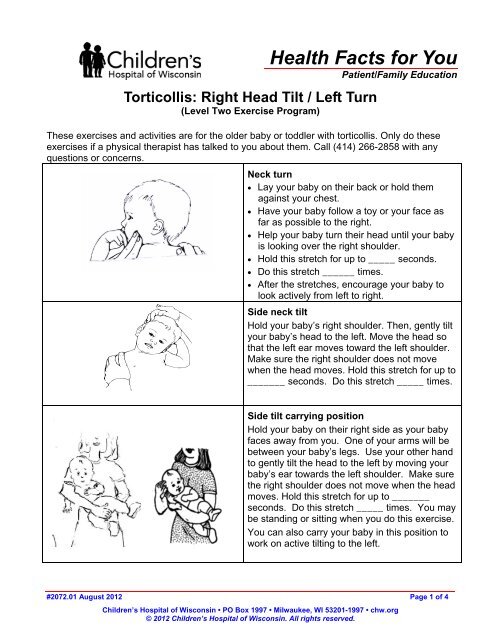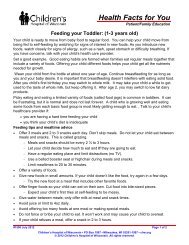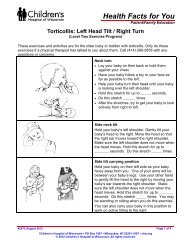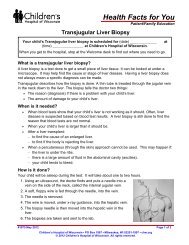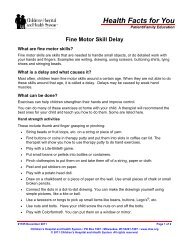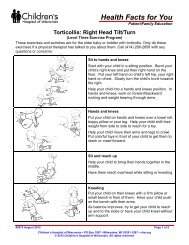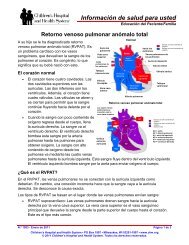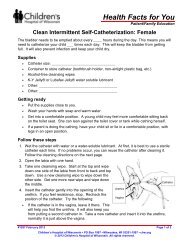Torticollis Right Head Tilt/Left Turn - Children's Hospital of Wisconsin
Torticollis Right Head Tilt/Left Turn - Children's Hospital of Wisconsin
Torticollis Right Head Tilt/Left Turn - Children's Hospital of Wisconsin
Create successful ePaper yourself
Turn your PDF publications into a flip-book with our unique Google optimized e-Paper software.
Health Facts for YouPatient/Family Education<strong>Torticollis</strong>: <strong>Right</strong> <strong>Head</strong> <strong>Tilt</strong> / <strong>Left</strong> <strong>Turn</strong>(Level Two Exercise Program)These exercises and activities are for the older baby or toddler with torticollis. Only do theseexercises if a physical therapist has talked to you about them. Call (414) 266-2858 with anyquestions or concerns.Neck turn• Lay your baby on their back or hold themagainst your chest.• Have your baby follow a toy or your face asfar as possible to the right.• Help your baby turn their head until your babyis looking over the right shoulder.• Hold this stretch for up to _____ seconds.• Do this stretch ______ times.• After the stretches, encourage your baby tolook actively from left to right.Side neck tiltHold your baby’s right shoulder. Then, gently tiltyour baby’s head to the left. Move the head sothat the left ear moves toward the left shoulder.Make sure the right shoulder does not movewhen the head moves. Hold this stretch for up to_______ seconds. Do this stretch _____ times.Side tilt carrying positionHold your baby on their right side as your babyfaces away from you. One <strong>of</strong> your arms will bebetween your baby’s legs. Use your other handto gently tilt the head to the left by moving yourbaby’s ear towards the left shoulder. Make surethe right shoulder does not move when the headmoves. Hold this stretch for up to _______seconds. Do this stretch _____ times. You maybe standing or sitting when you do this exercise.You can also carry your baby in this position towork on active tilting to the left.#2072.01 August 2012 Page 1 <strong>of</strong> 4Children’s <strong>Hospital</strong> <strong>of</strong> <strong>Wisconsin</strong> • PO Box 1997 • Milwaukee, WI 53201-1997 • chw.org© 2012 Children’s <strong>Hospital</strong> <strong>of</strong> <strong>Wisconsin</strong>. All rights reserved.
<strong>Torticollis</strong>: <strong>Right</strong> <strong>Head</strong> <strong>Tilt</strong> / <strong>Left</strong> <strong>Turn</strong>Neck stretchPut your baby on their back over your lap withthe head supported with your hand. Slowlylower your baby’s head, while holding theirshoulders down. Use toys or a mirror fordistraction.RollingHelp your baby roll over on their right side withthe right arm stretched up overhead. Look forthe head to lift or tilt to the left while rolling.Help your baby at the hips or have them reachwith the opposite arm to start the movement.Tummy time on elbowsPut your baby on their stomach using a towel rollor boppy to help prop your baby onto theelbows. Be sure to prop equally on both arms.Practice at least three times every day. Haveyour baby try to look up and to the right side.Tummy time on straight armsPut your baby on their stomach and help yourbaby push up onto straight arms. Be sure to useboth arms equally. Help your baby shift theirweight from side to side in this position. Practiceat least three times every day. Have your babytry and look up and to the right side.You can also put your baby over your leg or afirm pillow. Have your baby push up withstraight arms. Try to get your baby to look up.Reach to feetTry to get your baby to reach for their feet whilelying on the back. Help by gently bending yourbaby’s legs and helping touch their feet.Sometimes it is helpful to have your baby reachfor a toy, jingle socks or Velcro rattle.#2072.01 August 2012 Page 2 <strong>of</strong> 4
<strong>Torticollis</strong>: <strong>Right</strong> <strong>Head</strong> <strong>Tilt</strong> / <strong>Left</strong> <strong>Turn</strong>Pull to sitWith your baby on their back, put your handsbehind their shoulders. Have your baby look upat you. Gently help your baby into a sittingposition having them do most <strong>of</strong> the work. Youmay also work on moving from sitting back downto back lying. Remember to do this after diaperchanges.High side lyingHave your baby sit or lean on their right sidebearing weight on the forearm. Look for a headtilt to the left as your baby reaches forward withthe left arm.Push to sitStart with your baby lying on the right sidebearing weight on the forearm. Help your babypush up to sitting with your right hand undertheir trunk and your left hand on the left hip. Letyour baby do as much <strong>of</strong> the work as possible.Look for a head tilt to the left (ear to shoulder).Side sitHelp your baby side sit to the right bearingweight on the right hand. Look for a midlinehead position or a tilt to the left and good weightbearing on the arm. Have your baby reach outwith the left hand.Prop sitHelp your baby bring their arms forward and putweight on the arms in a sitting position with legsextended. Help your baby push up into uprightsitting again.#2072.01 August 2012 Page 3 <strong>of</strong> 4
<strong>Torticollis</strong>: <strong>Right</strong> <strong>Head</strong> <strong>Tilt</strong> / <strong>Left</strong> <strong>Turn</strong>Midline sitting activitiesWork on forward reaching with both arms in themiddle while sitting.Work on having your baby reach across themiddle <strong>of</strong> their body with the left hand while theirright hand is on the ground/floor.Trunk strengtheningHelp your baby strengthen their trunk and neckwhile sitting. Do this by tilting your baby’s bodyto the side, forward and backwards in a diagonalpattern. Look for your baby to return to amidline position after you tilt them.Carry your baby facing out to encourage lookingto the right.PositioningUse a folded washcloth ¼ – ½” thick tapedunder your baby’s left buttock when they aresitting on the floor and playing or in a high chair.This will help your baby tilt their head to the leftto strengthen the neck muscles in this position.Illustrations courtesy: Therapy Skill Builders Inc. (3830 E Bellevue, PO Box 42050, Tucson AZ 85733)Visual Health Information (PO Box 44646, Tacoma WA 98444)VORT Corporation (PO Box 60132, Palo Alto, CA 94306)ALERT: Call your child’s doctor or physical therapist if you have any questionsor concerns or if your child has special health care needs that were not coveredby this information.This teaching sheet is meant to help you care for your child. It does not take the place <strong>of</strong> medical care.Talk with your healthcare provider for diagnosis, treatment, and follow-up.#2072.01 August 2012 Page 4 <strong>of</strong> 4


